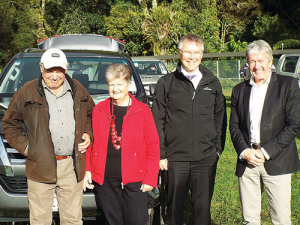Damien O’Connor: NZ united on global trade
When it comes to international trade, politicians from all sides of the aisle are united, says Labour's trade spokesman Damien O'Connor.
 Environment Minister David Parker and Agriculture Minister Damien O’Connor with Cambridge farmers Bill and Sue Garland.
Environment Minister David Parker and Agriculture Minister Damien O’Connor with Cambridge farmers Bill and Sue Garland.
The double-D’S were front and centre at Karapiro, Waikato, recently to promote a voluntary water quality initiative.
David Parker and Damien O’Connor, ministers for the environment and agriculture, respectively, joined industry leaders to endorse the Good Farming Practice-Action Plan for Water Quality 2018.
The plan was developed largely from principles set out in the 2015 Industry-Agreed Management Practices first applied by Environment Canterbury.
The voluntary initiative is led by Federated Farmers, Beef + Lamb NZ, Dairy NZ, Horticulture NZ, Irrigation NZ and people from regional councils and regulatory authorities.
The chief aim is to help make rivers swimmable and to improve the ecology of waterways, so the plan advocates good farming practices -- assessing individual and regional catchments, measuring and showing improvements and telling the public about progress.
At grassroots level this will see workable plans being drawn up to identify physical and topographical constraints, and identify land where cropping should cease because of erosion risks. The plan includes keeping accurate records of inputs and outputs, and managing run-off, sediments and nutrients entering waterways.
Environment Minister David Parker applauded the voluntary nature of the plan and conceded that regulation “might not be the b-all and end-all”. But he said rules and regulations would be part of the solution, as would better education and perhaps “pricing” to influence behaviour.
Parker’s former flatmate Minister Damien O’Connor noted “the need for guidelines in tune with the environment, and for a part of the social licence that allows landowners to operate”.
NZ agriculture and horticulture needs to be the best producer in the world, he said, with their output “food for people who care, produced by farmers and growers who care”.
The plan now is to spend the next two years enlisting farms and local and regional authorities in a campaign going through to 2030.
|
A landmark moment for New Zealand. That's how Prime Minister Christopher Luxon describes the conclusion of negotiations for an India-New Zealand Free Trade Agreement. Beef Progeny Test 2025: Genetic insights for NZ beef industryAt Pāmu’s Kepler Farm in Manapouri, mating has wrapped up at the across-breed Beef Progeny Test. HortNZ celebrates 20 YearsMore than 150 people turned up at Parliament recently to celebrate the 20th anniversary of Horticulture New Zealand (HortNZ). Biosecurity NZ urges vigilance for yellow-legged hornetsBiosecurity New Zealand says Kiwis should continue to keep an eye out for yellow-legged hornets (Vespa velutina) over the holiday season. Mental Health and Fitness Unite: The Push-Up Challenge comes to New ZealandThe Push-Up Challenge, an event which combines mental health and fitness, is set to launch in New Zealand in 2026. Agritechnica 2025: Claas, Fendt and Valtra claim 2026 Tractor of the Year AwardsLast month's Agritechnica event led to a wide group of manufacturers celebrating successes when the 2026 Tractor of the Year Competition winners, selected by a panel of European journalists, were announced in Hanover Germany. NationalFonterra capital return could boost GDP – ANZ ReportThe Fonterra divestment capital return should provide “a tailwind to GDP growth” next year, according to a new ANZ NZ report,…Fonterra upgrades Eltham cheese production for global growthFonterra's Eltham site in Taranaki is stepping up its global impact with an upgrade to its processed cheese production lines,…Michelle Pye elected to Fonterra boardCanterbury farmer Michelle Pye has been elected to Fonterra’s board for a three-year term.Government plan to scrap regional councils faces criticismGovernment plans to get rid of regional councillors shows a lack of understanding of the fundamental problem affecting all of…Lactose to join fat and protein in Fonterra milk price modelFor over 20 years, Whakatane farmer Gerard Van Beek has been attending Fonterra annual general meetings with the same message…Machinery & ProductsCase IH Unveils New RB6 Round Balers & 2026 Square Baler UpgradesCase IH has released details of its all-new round balers and redesigns to its large square balers aimed at increasing…How to Improve Milking Efficiency in Swing-Over Herringbone ShedsThe swing-over herringbone is the most common dairy type in New Zealand, used on 69% of dairy farms. Simple changes…Claas Jaguar 1000 Series sets new forage harvesting world recordThe recently released Claas Jaguar 1000 Series has seen its flagship 1200 set a new official Guiness World Record in…CB Norwood appoints John Skurr as new general managerCB Norwood Distributors Limited has announced the appointment of John Skurr to the position of general manager.AIMER, Bovonic and Herd-i join forces to advance NZ dairy techThree New Zealand agritech companies are set to join forces to help unlock the full potential of technology.» Latest Print Issues OnlineMilking ItTrump's tariffsPresident Donald Trump’s decision to impose tariffs on imports into the US is doing good things for global trade, according… Tanker on the rollSeen a giant cheese roll rolling along Southland’s roads? » eNewsletter |